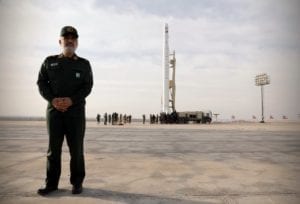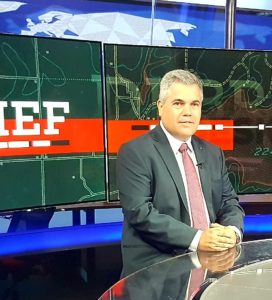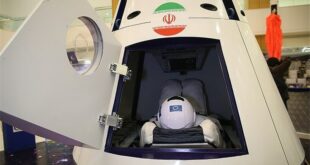
On 22 April 2020 Iran’s Islamic Revolutionary Guard Corps (IRGC) successfully launched a small satellite – the Noor-1 (Farsi for ‘Light’) – on a previously unseen satellite launch vehicle called the Qased. Over the course of this week SpaceWatch.Global is running a series of perspectives on the strategic, political, and geopolitical implications of the launch for Iran, the Middle East region, Europe, and the United States. Today’s perspectives come courtesy of Tal Inbar, one of Israel’s leading experts on space policy and missile systems (below), and Fabian Hinz, Research Associate at the James Martin Center for Nonproliferation Studies at the Middlebury Institute of International Studies in Monterey, California, United States (see here).
What are the strategic implications of the launch for Israeli and regional security?
It is the first time that an Iranian satellite is designated as a military satellite and both the satellite and the launcher are the product of the IRGC, rather than the Iranian Space Agency (ISA) and/or another civilian governmental ministry. In February 202o, the IRGC unveiled part of its clandestine space project – the Salman solid rocket motor, the first Iranian large solid propelled rocket motor with steerable nozzle (for thrust vectoring). In November 2019, the IRGC aired a short video depicting Hassan Teharani Mougadem with an even larger solid rocket motor, described as a motor for a future SLV. The last possible date of the video is November 2011, so it is obvious that the space program of the IRGC has been in existence for many years – but under wraps.
Do you believe that Iran now has a militarily useful satellite, and if so what do you think it is capable of in the space domain? If not, do you believe that Iran has the capacity and resources to develop militarily useful satellites?
The satellite is clearly a 6U Cubesat platform, designed as a remote sensing satellite. The maximum aperture of the satellite telescope is less than 10 centimeters in diameter; hence the theoretical resolution of the satellite is low – making it only a crude military instrument for imagery intelligence (IMINT). However, if operating, it will be the first time that Iran will be able to collect images of various areas independently, so the value of the satellite is more on the declaration of capabilities, both for internal and external purposes. It could be sufficient for getting intelligence on large installations such as air force bases and oil related infrastructures.
Why do you think the IRGC has created its own Space Command?
There is a long struggle within the Iranian establishment among various organizations – and the IRGC was always the favorable organ to get funding, equipment, and responsibility over the armed forces (Army, Air Force and Navy). It is a well-known fact that the IRGC is responsible for both the development and operation of Iran’s ballistic missiles. The satellite launch vehicles of Iran have always been a direct derivative of its ballistic missiles, but official cover for the pre-Qased launch was the Iranian Space Agency. A parallel program was kept secret for years, and after several failures by the Iranian Space Agency, the decision was made to remove the veil from Iran’s secret space program. The IRGC has all the elements needed to conduct a space program, which is military in nature. The ISA’s last successful mission took place more than four years ago, in February 2015, when the Safir lifted a Fajr-3 satellite into low-earth orbit.
Is it useful to distinguish between an Iranian civilian space program and the IRGC space program?
Clearly there was a clandestine space program run by the IRGC in parallel with the space program of the ISA. But, one has to keep in mind that the launch vehicles and rocket engines, the ground infrastructure from vehicle assembly buildings to command and control stations to the transporter erector launchers (TEL’s) used to launch the ISA’s Safir SLV – all are of IRGC origin.
So, the best way to describe the once secret program of the IRGC is simply that is is another branch of Iran’s quest for space.
In your opinion, how should Israel respond, if at all, to the IRGC space program?
For now, Iranian satellite capabilities pose no threat so there is no immediate need for any response. As for the improvements in the launcher arena, it is advisable to monitor the capabilities, technologies, and chain of supply – for some elements of the launcher program could benefit Iran’s ballistic missile projects.

Tal Inbar is an independent researcher and analyst and was the head of the space and UAV canter at Israel’s Fisher Institute for Air and Space Strategic Studies. Mr. Inbar follows the ballistic missiles programs of various countries including North Korea, Iran and China, to name a few. He deals with both strategic and technical assessments of the missile programs, and briefed representatives from the US Senate and Congress, NATO, the US Air Force’s Space Command, and the European Parliament – among others. He is a visiting speaker on various think-tanks and research institutes including RAND, the Washington Institute for Near East Policy, Missile Defense Advocacy Alliance, Secure World Foundation – to name a few. Inbar has delivered congressional at the US capitol since 2016. He is also a speaker at various HCoC conferences, UNIDIR conferences in Geneva and the Security and Defense subcommittee of the European Parliament in Brussels. He has presented at the IMDA missile defense conferences since 2013.
 SpaceWatch.Global An independent perspective on space
SpaceWatch.Global An independent perspective on space




